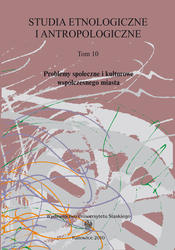

The article compares the points of view of two groups of respondents — the inhabitants of new and old districts of Upper Silesia concerning the space inhabited by them, its organization and division expressing the life styles and structure of an every day of its inhabitants. Nikiszowiec, a district of an almost symbolic character for the social and urbanist history was chosen as a representative of old districts whereas the new districts were represented by particular districts of Tychy. As a result of this comparison, the types of workers’ flats, in the perspective of tradition and Silesian culture as well as the contemporary flat and district patterns are presented. The subordination of the region to the heavy industry influenced the spacious organization of the Upper Silesian cities. The relation between the industry and pragmatics of an every day life was most strongly reinforced in old workers’ districts, at the earliest in the form of the industrial settlement in the region whereas the spacious shape of workers’ colonies built conditioned and consolidated the social norms, typical of the inhabitants of the region. The old workers’ districts of Silesian cities were formed on the basis of patron districts built from the half of the 19th century around the abruptly appearing and developing mines and steelworks. The organization of the living space in the area of Upper Silesia was always marked with a given specificity, expressing the obligatory life style, work division and structure of the Upper Silesian family. The block of a red brick was its symbol giving the frames to the everyday outlines of the living space. Nowadays, an example of the spacious unit in question is Nikiszowiec, the former mining colony placed next to “Wieczorek” mine in Katowice. However, different districts, though also working class ones in the plan, built after the World War II in the form of big city blocks of flats are to be found nearby. The creation of new flats for the working class started under the ideological caption of the necessity to eliminate the social inequalities within the scope of living conditions. As a result of it, the representatives of different classes, professions characterized by different social and regional origins are neighbours in the PRL like blocks of flats. In the name of socialistic ideas, the project, unique in form, of a socialistic city of Tychy, a big base for incoming and native people working in the region of GOP was created. Both types of buildings — the one in Nikiszowiec and Tychy — currently constitute the spacious landscape of Upper Silesia and the way of inhabiting them determines the frames of life of the contemporary inhabitants of the region.
Download files
Citation rules

Vol. 10 (2010)
Published:
 10.31261/SEIA
10.31261/SEIA